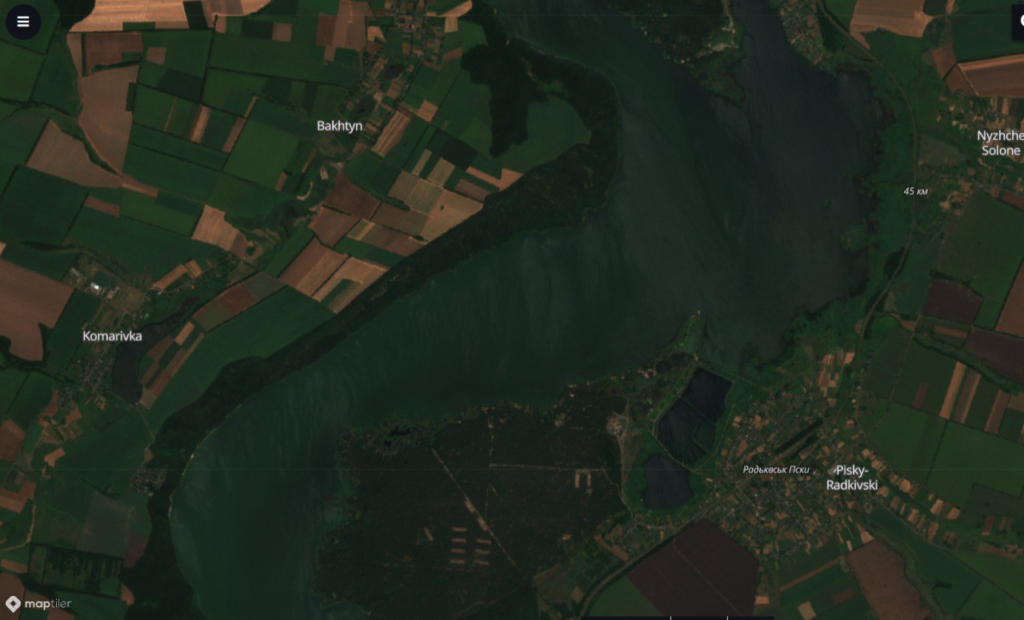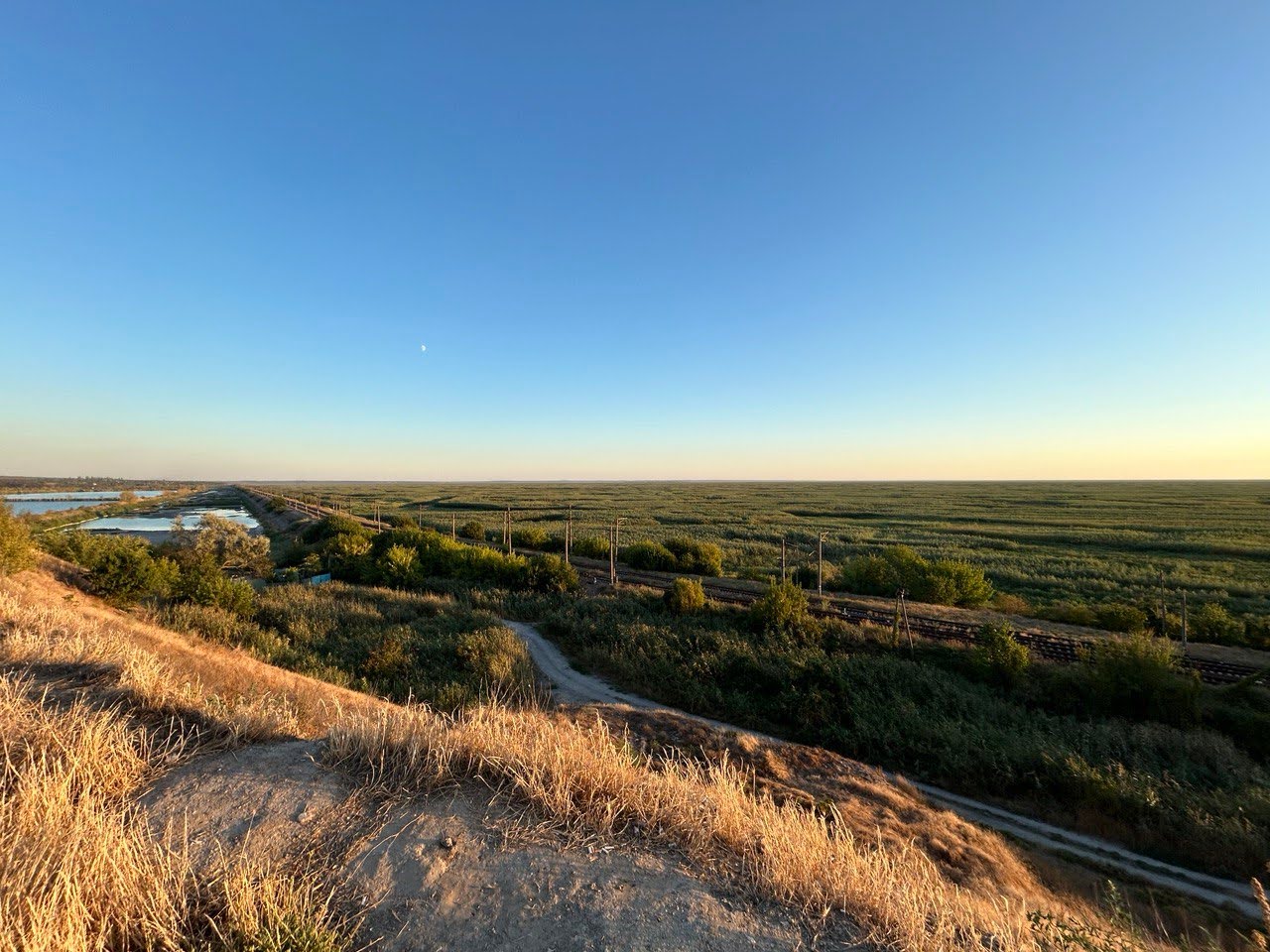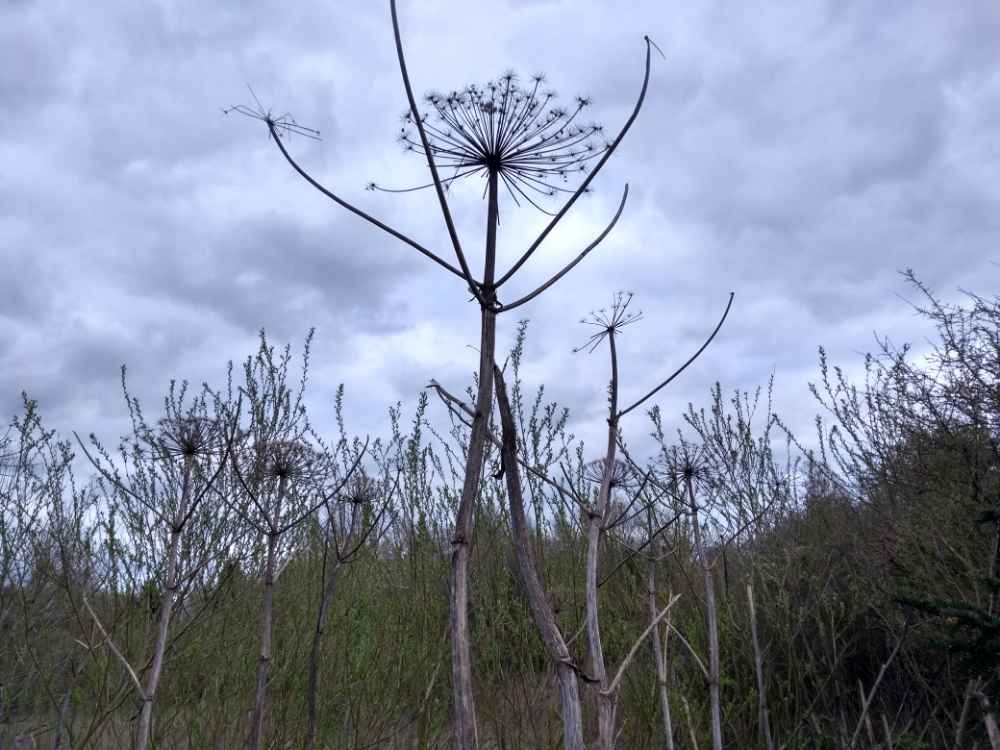By Valeriia Kolodezhna, Oleksii Vasyliuk, UNCG
About authors:
Oleksii Vasyliuk. Oleksii chairs the NGO Ukrainian Nature Conservation Group and is a biologist.
Valeriia Kolodezhna. Valeria is an expert in wetland biology at the NGO Ukrainian Nature Conservation Group and a geographer.
One of the biggest environmental changes caused by the Russian-Ukrainian war is the destruction of one of the gates of the Oskil Reservoir in the Kharkiv area on April 2. Roughly 355,500,000 cubic meters of water rapidly escaped from the reservoir, causing the level of the Siverskyi Dinets River to rise and exposing about 9,000 hectares of the silted bed.
Rising water levels in the Siverskyi Donets River, into which the Oskil flows, have helped to stop advancing Russian troops, who are to this day unable to cross the largest river in eastern Ukraine. Although these short-term tactical advantages are important for the protection of our state, the long-term environmental consequences are less clearcut. The Oskil Reservoir was created to regulate water levels in the Siverskyi Donets-Donbas Canal (maintaining water volume in summer, when the Siverskyi Donets River flows). That is, this reservoir is directly related to the water supply for the vast majority of the population of Donetsk and Luhansk regions. Tangentially, the canal’s final destination is Mariupol.
Thus, local and regional governments are first-and-foremost concerned with any threats to the canal’s ongoing operations or water supply for the Donbas as a whole. Water supply in the Donetsk region is currently a worry not only for the Donbas Water Company, but also for the United Nations’ World Health Organization. Millions of Ukrainians are currently deprived of drinking water, including Ukrainian citizens in the temporarily occupied territories of the Donetsk and Luhansk regions.
Few seem to be worrying about the environmental consequences of the de facto elimination of the Oskil Reservoir.

Figure 1. Bare landscape of the Oskil Reservoir bed, late May 2022. Credit: Sentinel Hub
The reservoir has attained a respectable age; in 2022 it will be 65 years old. It is the largest reservoir on Ukraine’s Left Bank and is eighth in surface area and total volume for the country as a whole (122.6 sq km and 0.474 sq km, respectively). However, despite its impressive “dimensions,” 33.5% of the reservoir’s surface area is shallow water, which fish prefer for spawning and where significant sedimentation occurs. Average sediment depth ranges from 0.5 m in the lowlands up to 1 m in the river’s upper reaches. As a result, the reservoir’s water supply is swampy, with high phosphorus content, low water clarity, and mediocre water quality. In such conditions, although cases of fish suffocation are not uncommon, people have no other choice but to rely on this water supply system, for the last 65 years.
Considering that Siverskyi Donets-Donbas Canal pump units have also reached the end of their service life [1], perhaps the reservoir’s damage is a good opportunity to modernize the Donbas water supply system while giving nature what it deserves – restoration of the Oskil River’s natural floodplain. The floodplain’s natural features remain perfectly preserved beneath the former reservoir and are clearly visible, even from space.

Figure 2. Oskil Reservoir bed, 2021 Credit: Sentinel Hub
To understand what this means in wildlife terms, we must first understand these recent changes.
On the one hand, the vast majority of water drained away, exposing a significant area of the reservoir’s bed that is now subject to wind erosion. Vegetation on the former shores lost its usual hydrological regime and is unlikely to continue to exist prior to the rupture. This also applies to rare species, such as Gladious tenuis. The reservoir’s shallows were feeding and nesting grounds for many waterfowl, including rare birds. All of the organisms inhabiting the thick layer of now-exposed silt will die off, resulting in new problems. Most of the young fish and the fish population as a whole have been swept downstream, and there is insufficient appropriate habitat to restore former populations.
On the other hand, the dam has not been completely destroyed. The river’s flow has not been restored, and conditions necessary for fish to resume spawning and move freely past the dam do not yet exist.
Thus, the dam’s partial demolition destroyed temporary ecosystems formed on the artificial reservoir’s site, but did not create the conditions needed for natural restoration of a rheophilic ecosystem – a natural, unregulated channel with running water.
After the war, we will be at a crossroads. One option is to repair the dam, refill the reservoir, and transport its waters hundreds of kilometers south for another half a century. All the while consuming the electricity and, most importantly, human resources, need for maintaining this type of water supply. Another option is to allow nature to regrow the Oskil’s floodplains grasslands, restoring meadow landscapes on the left, flat bank of the river and limiting erosion on the right, high bank. From a wildlife perspective, the second option is most desirable, restoring the natural course of the river by dismantling the reservoir’s dam.
Let’s look at both options more closely.
Option №1. Return the reservoir to its former state and restore Oskil hydropower plant’s capacity
It takes time to fill reservoirs, a process that depends on conditions. For example, the first filling of the Oskil Reservoir to a normal operational level occurred between 1958 and 1977. No matter the duration, the temporary but greater water demands will not go unnoticed for the Oskil River, its floodplain, and downstream flora and fauna. Below the dam, pioneer plants will increase shallows and overgrow the riverbed. Afterward, the dam will hold back river sediments, and water clarity below it will increase in the area of Sinichynskyi Landscape Reserve. That reserve’s goal is to preserve the Oskil River’s natural features, riparian and aquatic ecosystems, and rare plant and animal species. River blockage or even a significant decrease in runoff will lead directly to destruction of the reserve’s natural value.
In the years after refilling, the reservoir’s restoration will make it possible to replenish the Siverskyi Donets-Donbas canal as well producing roughly 11 GWh/year of electricity at the Oskil hydropower plant. But this capacity is actually equal to the average annual generation of a single Vestas windmill, of which at least 500 are installed in various parts of southern and eastern Ukraine. The plant’s electricity production dims still further when you factor in the energy needed to pump water at the canal’s four pumping stations. According to 2021 Water of Donbas Municipal Enterprise data, electricity consumption costs reached 41% of the total cost of water supply. We can assume that replacing the equipment of even a few of the 64 water pumping stations with energy-saving technologies, the Oskil plant’s potential produced energy levels out as much more electricity is needed to maintain the canal than the plant can produce. The Donetsk region is one of the least water-supplied regions in Ukraine. Thus, if the reservoir is refilled and necessary water discharges take place, it will include 50 million m³ of water to supply the Siverskyi Donets-Donbas canal, where its primary use is industrial. This removes not only millions of cubic meters of water from the river, but there are additional water losses during transportation in the canal, an amount that reaches 65-69%. Again, these losses again point to the need for modernization.
Given the large area of shallow water and stagnant water regime, the water in Oskil Reservoir will constantly “bloom”, and, given long-term climate forecasts, this problem will worsen. According to hydrobiological measurements in 2016, phytoplankton in water samples exceeded 100 cells/cm³. Prior to the accident, the blue-green algal “blooming” at the dam reservoir was quite long thanks to abnormally high air and water temperatures. This story will be repeated if the reservoir is refilled, likely resulting in recommendations to avoid recreation and fishing in the area. Fishing is already badly impacted by eutrophication, resulting in fish die-offs caused by suffocation and low fry survival rates in early summer (especially when water levels are lowered rapidly). The figures speak for themselves: while in 2017 the actual catch of fish in the reservoir reached 13.61 metric tons/year (with a total allowable catch of 19.58 tons/year), in 2020 it was half that amount – just 6,076 tons/year. The changing climate warms shallow water bodies such as the Oskil Reservoir, resulting in negative consequences that could be eliminated by restoring the river’s full flow. If the restoration path is chosen, it will be the restoration of inefficient, environmentally problematic, and economically unprofitable infrastructure.
Option №2. Dismantle the dam of the Oskil Reservoir and restore the natural course and floodplain of the Oskil River
The practice of removing old and small/offline dams has long been acceptable in the EU and the US and is actively spreading further today. 2021 was a record year – 239 abandoned or dilapidated dams were dismantled in the EU; a thorough study of the pre- and post-conditions of their decommissioning was conducted for each of them.
Restoring the Oskil River’s flow solves several problematic issues in the region, problems that were highlighted in a report on the state of the environment in Donetsk region in 2019 [3]. The “According to the ‘Improvement to the hydrological regime and ecological condition of the Siverskyi Donets River in Kharkiv, Donetsk, and Luhansk regions feasibility report,’ indicates excession obstruction to the river’s flow. The obstruction coefficient is 1.54, based on the high number of freshwater reservoirs and ponds in the river basin. One option presented sought to “determine the feasibility of operation of hydraulic structures in reservoirs.” This option is absolutely appropriate in the case of the Oskil Reservoir.
Let’s imagine what will happen if, after expert analysis, further operation of the reservoir and hydroelectric power plant is deemed inexpedient (as laid out in the brief overview above), and the dam is dismantled. It is very important that solutions aimed at solving environmental problems are truly environmentally friendly. For example, in order to prevent water levels in the reservoir from being lowered, communities may begin to develop previously inaccessible “land resources” by plowing or building up reclaimed areas. The reservoir bed will remain bare only temporarily; floodplain meadows will regrow and become a natural oasis for people and animals.
First of all, restoration of the Oskil’s natural runoff will give many fish species the opportunity to return to their habitats, a process predicated on running water and an unblocked channel. These fish populations are a ready prey base for bird species nested in reed thickets around the former reservoir or for those birds that will return to restored floodplain landscapes. Of course, this also includes species protected by Ukraine’s Red Book that require free-flowing water.
Unfortunately, the reservoir’s detrimental effects have not only affected wildlife. The right bank of the river, with its higher elevation and picturesque Cretaceous outcroppings, has suffered significant damage from storm surges up to 1 m in height during the reservoir’s existence. When the river again begins to flow naturally, water quality will increase and phosphate levels will be naturally regulated. This will eliminate the problem of eutrophication, because organic impurities, including phosphates (which are significantly elevated above normal in the reservoir samples), served as a kind of catalyst for the growth of photosynthetic algae.
While the economic profitability of the reservoir’s water resources and generated energy at Oskil Hydropower Plant can be questioned (above, Option №1: Restore the reservoir), the water-regulating function of the dam remains relevant. The water in the Oskil rises an average of 5 m during spring flooding, an amount that should not threaten villages along the river with flooding. However, no one is safe from above average flooding, especially in the context of global warming. Examining the experience of the state of California in the United States, the observation can be made that it is natural floodplains, rather than channel blocking, that represent sustainable solutions for climate change. After liberating the river of its dam, new wastewater treatment and drainage systems are designed. There are several options: build rainwater runoff basins, or, in the case of herbaceous plants on the site of a former reservoir, build filtration buffer strips. This approach has not yet been implemented in Ukraine, but the United States and Europe have a sufficient number of successfully completed projects and people willing to share their experiences.
The potential restoration of the Oskil River’s natural course is the first conscious step to free Ukrainian rivers from dams. As the largest country in Europe, Ukrainians are in a position to assert an environmentally conscious position while deepening ties and sharing experiences with friendly countries. A decision to dismantle this dam will accelerate decisions on the modernization of water supply systems in Donbas. But in addition to undoubtedly important infrastructure and economic functions, first and foremost, dam removal presents an opportunity to restore dozens of species of flora and fauna to their natural habitats. This is truly a step for humanity toward reconciliation with nature.







Comments on “Should the Oskil Reservoir
be rebuilt after the war?”